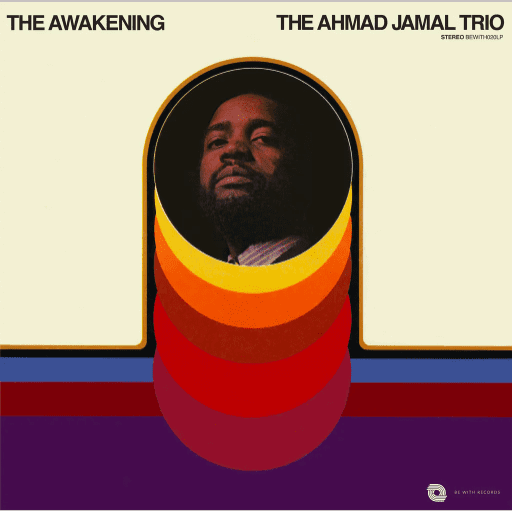
Written by Joshua Edmunds
Ahmad Jamal’s 1970 Album The Awakening stands as a textbook example of an exceptional jazz album. Recorded at Plaza Sound Studios in New York City, the album carries the ferocity of the city in its presentation. Dizzyling dissonant arpeggios dance in fifteen second intervals all over this record. Jamal’s phrasings stick in groups of threes and fives, and sudden shifts keep the seven song tracklist harmonically and rhythmically dense. Jamal worked with drummer Frank Gant and bassist Jamil Nasser in the seven song tracklist. Along with bassist Jaco Pastorius’ Trio of Doom, Jamal follows a path of jazz musicians flourishing in their musical identity when working in a trio.
The first track, “The Awakening” highlights Jamal’s lyricism on piano and well as his pendant for delicacy in his phrases. He refuses to stay comfortable with a specific key for more than a few seconds, and Gant’s steady drumming allows Jamal to dance like an acrobat as opposed to a piano player. His use of sixth chords borrows from heavyweights Oscar Peterson and Thelonius Monk’s work with record label Blue Note in the 1950s, but his charisma and flavor makes Jamal’s work distinctly his own. The intro introduces the listener to Jamal’s whimsical and fascinating world, and jazz fans have much to analyze with the trio’s passages.
“I Love Music” is an eight minute fan favorite; half solo piano from Jamal followed by the band coming in for the rest of the track. “Patterns” and “Dolphin Dance” keeps the energy light and playful, and his treatment on Miles Davis’s version makes the two songs sound near unrecognizable. “You’re My Everything” and “Stolen Moments” introduce somber tones into the record, but the trio’s chemistry prevents their arrangements from being slow and pedantic.
Jamal’s albums would receive a resurgence during the 1980s where numerous hip-hop acts began sampling his music. Nas utilized producer Pete Rock’s ear in sampling “I Love Music” twenty five years later in his standout single from 1995’s Illmatic “The World Is Yours.” As a seven-minute solo performance, Jamal’s runs range from dashingly playful to thunderous within seconds. Track 3’s Patterns is light and playful in its presentation, and its lilting like quality benefits from the synchronized playing of the trio. One feels shocked by the quality of sound produced by only three men.
Jamal’s The Awakening was a crucial influence on trumpeter Miles Davis, who praised Jamal’s playing style on multiple occasions. As a frequent Jamal listener, his music invites contemplation and a sense of mindfulness. The tracklist nets two originals, a cover of Herbie Hancock’s Dolphin Dance and Antonio Carlos Jobim’s Wave. By spinning his own take on jazz standards, Jamal broadcasts his originality in that his versions stand as clear departures from the original source material. His playfulness and willingness to experiment with dissonant harmony makes his chords rich and colorful.
Opponents to his style may call his playing too melodic or much like “coffee-table music” but his singular focus serves as an antidote to our over-saturated and commercialized world. Simple yet lush, experimental yet familiar, steady and yet incredibly adventurous.
Track seven’s “Wave” shows Jamal’s bossa nova and Eastern music influence By ending his album on a cover by Jobim, he illustrates his reference for musicians who came before him as well as reinventing their signature songs. Jobim’s writing had become standard practice in Brazil and the US by 1970, and Jersey-born Frank Sinatra released a series of collab albums with Jobim in 1964.
Ed Michel, the producer and engineer behind The Awakening was known for working with prolific jazz artists. Jazz greats like B.B King and Alice Coltrane were mainstays in his clientele, and his results on the mix illustrates Michel’s ferocious work ethic. Every sound feels balanced, but in its playfulness Jamal’s chords, Gant’s steady drumming, and Nassers’ upright bass force listeners to pay attention to the mix. Engineers like Rudy Van Gelter set a precedent with his microphone placement and drum recording techniques for Blue Note records, and their influence is clear as day throughout this record.
The cover art relies on standard color theory in its presentation, which highlights Jamal’s sunny demeanor and playing style. The different gradients of circular beige and red tones contrast against the white background and corner typography. It borrows from the Blue Note covers popularized by photographer Francis Woolf, but Jamal’s face stares at you from 1970. He looks upward, as if he’s seeing a god, but one wonders if he’s just listening to the music inside his head.
Jamal’s reputation and work ethic preceded him, and he has gone on to become one of the most celebrated performers in jazz music. The coin flip between obscurity and international success seems to be more fate than skill-based, but The Awakening stands as a textbook example of a fantastic jazz record that defined a career shift for Jamal.

